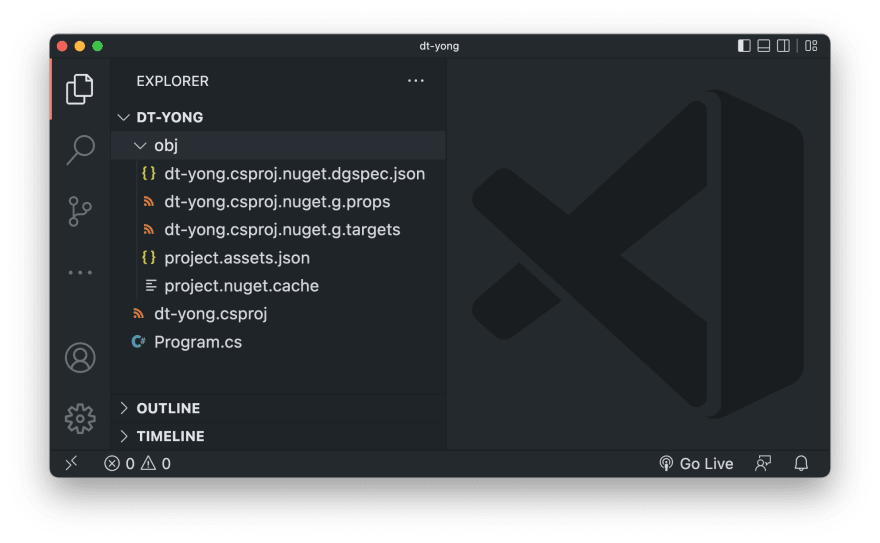This content originally appeared on DEV Community and was authored by Yongchang He
In this article, I will use DT for Digital Twin.
Prerequisites
knowledge about Azure DT
Any code editor (VS Code is preferable, and you don't need to install .NET Core)
.NET Core installed
Azure DT instance created
Getting Started
Project Setup
The very first is to create a minimal C# project in the created directory:
mkdir new-dt
cd new-dt
dotnet new console
Then you want to add two dependencies to your project: one is the package for the Azure DT SDK for .NET, and the other is tools to help with authentication management:
dotnet add package Azure.DigitalTwins.Core
dotnet add package Azure.Identity
Then we add the following two pieces of code to Program.cs to add necessary dependencies and authentication functionality:
Add this on the top
using Azure.DigitalTwins.Core;
using Azure.Identity;
And add this below the 'hello world' line in
Mainmethod, and do not forget to set the value ofadtInstanceUrlto your instance host name:
string adtInstanceUrl = "https://<your-Azure-Digital-Twins-instance-hostName>";
var credential = new DefaultAzureCredential();
var client = new DigitalTwinsClient(new Uri(adtInstanceUrl), credential);
Console.WriteLine($"Service client created – ready to go");
Now we can save the project (or preferablly commit to your git) and run the command below to test our previous work:
dotnet run
The console will print the following if no error occurs:
Hello World!
Service client created – ready to go
Model Upload
We can create models using Digital Twins Definition Language (DTDL, a kind of language similar with OOP programming language).
Let's create a new file named SampleModel.json, and paste the following code into it:
{
"@id": "dtmi:example:SampleModel;1",
"@type": "Interface",
"displayName": "SampleModel",
"contents": [
{
"@type": "Relationship",
"name": "contains"
},
{
"@type": "Property",
"name": "data",
"schema": "string"
}
],
"@context": "dtmi:dtdl:context;2"
}
After that, you want to add the rest of the code in Program.cs in order to interact with your DT instance (including code previously pasted):
using System;
// <Azure_Digital_Twins_dependencies>
using Azure.DigitalTwins.Core;
using Azure.Identity;
// </Azure_Digital_Twins_dependencies>
// <Model_dependencies>
using System.Threading.Tasks;
using System.IO;
using System.Collections.Generic;
using Azure;
// </Model_dependencies>
// <Query_dependencies>
using System.Text.Json;
// </Query_dependencies>
namespace DigitalTwins_Samples
{
class DigitalTwinsClientAppSample
{
// <Async_signature>
static async Task Main(string[] args)
{
// </Async_signature>
Console.WriteLine("Hello World!");
// <Authentication_code>
string adtInstanceUrl = "https://<your-Azure-Digital-Twins-instance-hostName>";
var credential = new DefaultAzureCredential();
var client = new DigitalTwinsClient(new Uri(adtInstanceUrl), credential);
Console.WriteLine($"Service client created – ready to go");
// </Authentication_code>
// <Model_code>
Console.WriteLine();
Console.WriteLine("Upload a model");
string dtdl = File.ReadAllText("SampleModel.json");
var models = new List<string> { dtdl };
// Upload the model to the service
// <Model_try_catch>
try
{
await client.CreateModelsAsync(models);
Console.WriteLine("Models uploaded to the instance:");
}
catch (RequestFailedException e)
{
Console.WriteLine($"Upload model error: {e.Status}: {e.Message}");
}
// </Model_try_catch>
// <Print_model>
// Read a list of models back from the service
AsyncPageable<DigitalTwinsModelData> modelDataList = client.GetModelsAsync();
await foreach (DigitalTwinsModelData md in modelDataList)
{
Console.WriteLine($"Model: {md.Id}");
}
// </Print_model>
// </Model_code>
// <Initialize_twins>
var twinData = new BasicDigitalTwin();
twinData.Metadata.ModelId = "dtmi:example:SampleModel;1";
twinData.Contents.Add("data", $"Hello World!");
string prefix = "sampleTwin-";
for (int i = 0; i < 3; i++)
{
try
{
twinData.Id = $"{prefix}{i}";
await client.CreateOrReplaceDigitalTwinAsync<BasicDigitalTwin>(twinData.Id, twinData);
Console.WriteLine($"Created twin: {twinData.Id}");
}
catch(RequestFailedException e)
{
Console.WriteLine($"Create twin error: {e.Status}: {e.Message}");
}
}
// </Initialize_twins>
// <Use_create_relationship>
// Connect the twins with relationships
await CreateRelationshipAsync(client, "sampleTwin-0", "sampleTwin-1");
await CreateRelationshipAsync(client, "sampleTwin-0", "sampleTwin-2");
// </Use_create_relationship>
// <Use_list_relationships>
//List the relationships
await ListRelationshipsAsync(client, "sampleTwin-0");
// </Use_list_relationships>
// <Query_twins>
// Run a query for all twins
string query = "SELECT * FROM digitaltwins";
AsyncPageable<BasicDigitalTwin> queryResult = client.QueryAsync<BasicDigitalTwin>(query);
await foreach (BasicDigitalTwin twin in queryResult)
{
Console.WriteLine(JsonSerializer.Serialize(twin));
Console.WriteLine("---------------");
}
// </Query_twins>
}
// <Create_relationship>
public async static Task CreateRelationshipAsync(DigitalTwinsClient client, string srcId, string targetId)
{
var relationship = new BasicRelationship
{
TargetId = targetId,
Name = "contains"
};
try
{
string relId = $"{srcId}-contains->{targetId}";
await client.CreateOrReplaceRelationshipAsync(srcId, relId, relationship);
Console.WriteLine("Created relationship successfully");
}
catch (RequestFailedException e)
{
Console.WriteLine($"Create relationship error: {e.Status}: {e.Message}");
}
}
// </Create_relationship>
// <List_relationships>
public async static Task ListRelationshipsAsync(DigitalTwinsClient client, string srcId)
{
try
{
AsyncPageable<BasicRelationship> results = client.GetRelationshipsAsync<BasicRelationship>(srcId);
Console.WriteLine($"Twin {srcId} is connected to:");
await foreach (BasicRelationship rel in results)
{
Console.WriteLine($" -{rel.Name}->{rel.TargetId}");
}
}
catch (RequestFailedException e)
{
Console.WriteLine($"Relationship retrieval error: {e.Status}: {e.Message}");
}
}
// </List_relationships>
}
}
You should now interact with your digital twins using dotnet run.
Part of the result
Hello World!
Service client created – ready to go
Upload a model
Models uploaded to the instance:
Model: dtmi:example:Floor;1
Model: dtmi:example:Room;1
Model: dtmi:example:SampleModel;1
Created twin: sampleTwin-0
Created twin: sampleTwin-1
Created twin: sampleTwin-2
Created relationship successfully
Created relationship successfully
Twin sampleTwin-0 is connected to:
-contains->sampleTwin-1
-contains->sampleTwin-2
....
References
Code a client app
https://docs.microsoft.com/en-us/azure/digital-twins/tutorial-code
Cover image
https://www.ciobulletin.com/cloud/azure-digital-twins-generally-available
This content originally appeared on DEV Community and was authored by Yongchang He
Yongchang He | Sciencx (2022-07-25T15:55:31+00:00) Work With Azure Digital Twin – code a client app. Retrieved from https://www.scien.cx/2022/07/25/work-with-azure-digital-twin-code-a-client-app/
Please log in to upload a file.
There are no updates yet.
Click the Upload button above to add an update.

